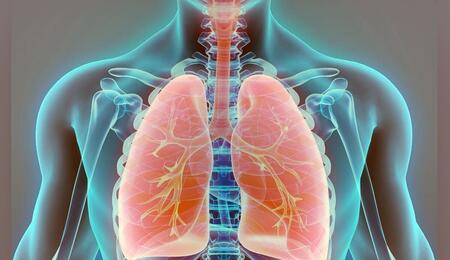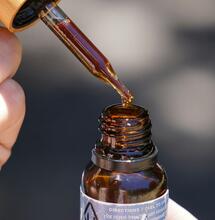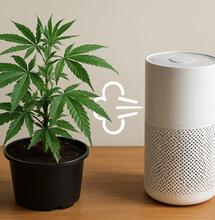How To Smoke Weed and Keep Your Lungs Healthy

Let’s keep it straightforward from the start: smoking is not good for your lungs. Inhaling any kind of smoke, including smoke from weed, could negatively impact your lungs’ health. Because particles released with combustion are never really good. But, is there anything you can do to clean out your lungs when you are an active smoker?
The Bizarre Truth About Cannabis Smoke
Researchers have of course dug into the question of whether smoking cannabis could cause serious health problems. The results from research are varied. One study has shown that regular cannabis users are as likely to get lung cancer as the average person. Another study has shown that marijuana users who’ve smoked one joint a day for up to 20 years did not show signs of lung damage; results were based on studying spirometry data, the breathing test that measures airflow as you exhale. However, multiple other studies have found that smoking cannabis does add up on tar in our lungs, and as everyone knows, tar contains a bunch of harmful chemicals.
Heavy Smokers Are at Increased Risk of Deteriorating Lung Health
While there might not be as significant a relationship between cannabis and lung cancer, heavy smokers still face some worrying risks. Continued heavy smoking, or consuming several joints a day for many years, may result in losing some of the lung capacity to make full, forced exhalations. Long-term exposure to smoke also increases the chances of inflammation, and leaves you more vulnerable to other lung conditions such as bronchitis, COPD or asthma.
These risks are believed to be reduced with vaporizing cannabis. It’s important to remember the obvious here, that when you smoke cannabis, you’re breathing in hot, smoldering plant matter into your body. On the other hand, vapes use just enough heat to activate the cannabinoids in your buds or badder, plus you are spared from the itchy burn of weed that as it nears the crutch it gets more and more uncomfortable on the throat.
In addition, when smoking a joint or a spliff, some harmful toxins are also released from the rolling papers and the other paraphernalia that you use to smoke the herb material. Rolling papers are processed with various chemicals and they also have a narrow strip of glue along the edge - which could cause lung tissue damage as well. Opting for vapes would avoid all of these risks, but that doesn’t mean that vape is completely risk-free either. But that’s whole another topic for discussion.
How High Is the Risk of Lung Cancer from Smoking Marijuana?
Cannabis smoke contains many of the same cancer-causing toxins as tobacco. But compared to cigarette smoking, the absence of tumors is oddly noted. Which again doesn’t mean that you are completely out of risk. THC could possibly have a role in playing down the risk of lung cancer. Lab research has shown that THC can cause tumor cells to shrink and die. Though lab testing does not always translate to what happens clinically on the human body, and most lab testing is also done on animals.
Researchers have analyzed what are the chances of getting lung cancer from marijuana. One older study from 2008 has found that “the risk of lung cancer increased 8%” for each joint-year of cannabis smoking and after adjustment of other factors such as cigarette smoking. The odds were similar when you only smoked cigarettes. The risk was up 7% for each pack-year of cigarette smoking and after adjustment of other factors. “The highest tertile of cannabis use was associated with an increased risk of lung cancer,” the same research says. So, the most at risk cannabis users seem to be heavy tokers who smoke a lot of weed for many many years.
With or without research, it remains a fact that combusting marijuana releases similar compounds found in burning tobacco, thus the risk of those harmful toxins doing damage in the body remains. The more you smoke, the more damage you do.
Cannabinoids Might Mitigate Cancer Risk
Initial studies have shown that THC as well as other cannabinoids can act as tumor-killers in humans. Still, research has not been conclusive as cannabinoids may engage differently depending on the type of cancer cells. “There have been intriguing results from lab experiments looking at a number of different cancers, including glioblastoma brain tumors, prostate, breast, lung and pancreatic cancers. But the take-home message is that different cannabinoids seem to have different effects on various cancer types, so they are far from being a ‘universal’ treatment,” Cancer Research UK writes on their website.
What gives hope indeed is what has been seen in animal testing. Results from research on animals claims that THC can both slow and help prevent the growth and progression of tumors. One German study, which has tested the effects of cannabidiol CBD on lung cancer cells, suggests that CBD may help prevent cancers from moving around the body. In other words, it prevents cancer cells from ‘infecting’ healthy cells. The researchers within this study even suggested clinical trials using CBD as a treatment of lung cancer. Findings like this are important, because they may pinpoint why cannabis smoke doesn’t cause lung cancer. It just begs the question if the same substance that might cause cancer simultaneously works to stop it? The only way to know more about this is through gaining more scientific insights.
Different Types of Smokes and How to Play Safe
Every person has their own preferences when it comes to smoking weed. The popularity of joints, blunts and pipes is undisputable. However, in recent years, demand for concentrates and vapes is as well sky-rocketing. Both concentrates and vaporizing can produce more ‘high’ than smoked flower, and they are considered to be somewhat safer options than smoking. Knowing the advantages and disadvantages of different cannabis delivery methods can help you assess risks and protect your lungs.
Vaporization
Using a vape is generally thought to be a safer way of consuming cannabis compared to smoking. As mentioned earlier, vaporizers do not directly blast the herb with fire. THC is released with medium heat and you are spared from inhaling many of the harmful particles released with combustion. However, latest research is increasingly challenging the safety of vapes, as it emerges that certain oily compounds found in e-liquids might trigger respiratory problems. Choosing recognized brands over suspicious products is more than recommended to stay safe while vaping.
Joints & Pipes
It’s good to note that your standard Bic Lighter typically burns with a flame temperature ranging from 1,650 to 2,372 degrees Fahrenheit. Which is pretty hot! Smoking a joint, pre-roll, or a pipe means passing a very hot flame directly to your buds. Along with the cannabinoids you inhale, you are also taking in unfiltered hot smoke with every toke, and that causes lung irritation, air pathways irritation, as well as tar build-up. Using natural rolling papers or a screen for your pipe could help reduce the risks here.
Bongs & Water Pipes
Bongs, bubblers and water pipes all rely on water to cool down the hot herb and lower the smoke temperature before taking it in. Most devices do trap some of the contaminants that would otherwise turn into tar inside your lungs. But far from perfect, even with water-based methods you still get loads of contaminants. For less harm, look for larger pieces that increase the distance between the flame and your mouth, and supplement the device with ice.
Dabbing
Dabbing concentrates like Butane Hash Oil (BHO) are also very popular these days. When it comes to lung health, there are a couple of things to know about dabbing. The first one is using ice. A torch makes the smoke much, much hotter than any other method, but a water-based rig and crushed ice can help you cool down things. With dabbing, solvents also matter. Just a small amount of butane inhaled can cause headaches and irritate mucous membranes all around. If you find BHO products a bit too much, C02 extractions are easier on the lungs.

Why It’s Important to Use Good-Quality Weed?
Avoiding bad weed is another important thing you can do to keep your lungs healthy while smoking. In fact, who wants the schwag, the sketchy and low-quality buds? Sometimes it’s the only choice left, and while it’s okay to smoke bad weed in emergencies, just don’t make a habit out of it.
Just over a decade ago, there was no standardized quality control for marijuana. But thanks to the expansion of legal markets, high-quality weed has become much more accessible. All legal weed is tested for safety and contaminants. Which still doesn’t mean that the situation on the ground is ideal. There have been many frauds with lab testing in the U.S. in the last couple of years. If you scroll the news, you will see that contaminated weed still finds its way to the legal market, to the expensive dispensary shelves - from California and all the way to New York. So, even when you pay a big dollar for your buds, you cannot be hundred percent sure that you are buying high standard weed that was lab tested for pesticides and other chemicals. And just like inhaling too much butane solvent, breathing in unknown chemicals has consequences. Smoking pollutants can cause nasty cough, irritate the throat and the lungs, and activate allergies.
The good thing with regulation is that it will always try to address these problems. That’s why there is regulation in the first place - to create a safer consumer market for cannabis. Products found to contain contaminants are withdrawn from the market. Laboratories that produce false results have their work licenses revoked. For example, between Dec. 2023 and Sept. 2024, California authorities revoked the licenses of four big commercial laboratories because they were faking weed lab results.
If you still worry that you might end up with low-quality or contaminated weed, it’s good to know the tell-tale signs of bad weed.
Cleaning Your Lungs After Smoking
It’s only legit to ask: if smoking leaves various trash behind, can anything be done to clean out my lungs? There actually is something that you can do. From breathing exercises to optimizing your diet, there are certain precautionary measures that you can take to reduce the unwanted impact marijuana smoke has on your lungs.
What is the best exercise for your lungs? Deep breathing!
Why Breathing Matters?
Breathing, as you know, means taking in vital oxygen that keeps our human body going. There are two main types of breathing: deep breathing and shallow breathing. As we inhale, we either take air into the tops of our lungs, or we breathe deeply and fully throughout the organs. The more fully we breathe, the better. Deep breathing allows oxygen to travel all the way down and freshen up the entire lung tissue. The shallower we breathe, the more toxins, stale air, pollutants and god-knows-what-else stays trapped inside. All that extra stuff in our lungs has a direct impact on our health. Gunk that contributes to feeling tired and contributes to tissue degradation.
Lazy Lungs
Lungs need exercise and movement every single day. When you shallow breathing the entire time, you draw in little breath into the lungs. Sitting and resting puts lungs at half capacity. Your lungs will appreciate at least 20 minutes of more intense and productive work, such as taking a good brisk walk around the neighborhood or going to the supermarket by foot if that’s convenient for you. Think of these activities as giving a good push to your lungs to do their cleaning job and shake that tar and toxins build-up.
Exercises for Clearing Smoke from the Lungs
There are a number of quick and simple breathing exercises that could help you eliminate toxins and keep airways clean. In addition, breathing exercises can tone down anger or other negative emotions and generally help out when feeling stressed. Keeping correct posture is important for all breathing exercises. You don’t want to take a position that obstructs your body while taking deep breaths. If you are sitting, feet should be on the floor. If you choose to lay down, lay on your back and keep your arms relaxed on the sides of your body with the palms open. Just like when you prepare the body for meditation or for some yoga exercises.
4-7-8 Breathing
The 4-7-8 breathing exercise is a known method among many people who suffer from anxiety or insomnia. So, besides it helps pump fresh oxygen deep into the lungs, it’s a method that calms the mind, resolving rushing thoughts and agitation.
Inhale for 4 seconds
Hold for 7 seconds
Exhale for 8 seconds
Deep Belly Breath Breathing
Imagine that you are breathing deep into your belly. Just put the focus of your mind there. This is often done in meditation. Concentrate on raising your chest and navel, and go for long and slow inhalations and exhalations.
Inhale: minimum 5 seconds
Exhale: minimum 5 seconds
Inhale Left, Exhale Right
Take a seated position and use the thumb of the right hand to block off the right nostril and inhale long and deep through the left nostril. And vice versa. With the thumb of the left hand block the other nostril and breathe in with the free one. You can do it as many times you feel comfortable. This type of breathing will not only exercise your lungs left and right, but it’s also soothing for your mind and nerves.
If you like breathing exercises, you can always search the internet for more tutorials or sign up for meditation or yoga, where instructions on how to properly breathe are often an integral part of the classes. You can also do basic deep breathing while in the shower. The heated moisture could be very helpful for lung hygiene. Don’t smoke immediately before or after doing breathing exercises.
Lung Cleansing with Proper Diet and Herbs
You love marijuana, it’s your favorite herb. That’s why you’ve read this far, right? But remember that there are hundreds of other herbs that can be extremely beneficial for your health. Not only herbs but also foods that support the workings of your lung system. Adding those herbs and foods more often into your diet can significantly boost your lung health.
Use more often: ginger, green tea, citrus fruits, tomatoes, garlic, onion, broccoli, apples, berries, leafy greens, beets, beans, turmeric powder, nuts, oily fish, yogurt, avocado, olive oil.
Ginger by itself can be used for sore throat treatment as it reduces inflammation and helps break down mucus. Of course, sometimes antibiotics are the only way you’ll get away from a serious infection, but don’t underestimate the potential of natural medicines like ginger, which, in fact, have been used by humans for centuries.
Oregano, peppermint, eucalyptus, celery is also something that you can infuse more often in your diet. For instance, a few drops of concentrated oregano oil in olive oil does wonders for your salad taste, and is not only good for the lungs but your entire immune system.
Finally, don’t forget water. Good hydration is the best tonic for your body. Up to 60% of the human body is water, and lungs have a bit more of it compared to other organs. Lungs are amazing 83% water so they do need tonifying.
If you are worried about your lung health, reach out to a health professional. If you are a smoker, screen your body for cancer every now and then. Eat healthy, consume moderately and follow the latest research on cannabis to be in the know of the herb’s full health benefits and potential risks.
Also read on Soft Secrets:
.jpg)














